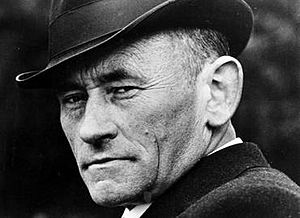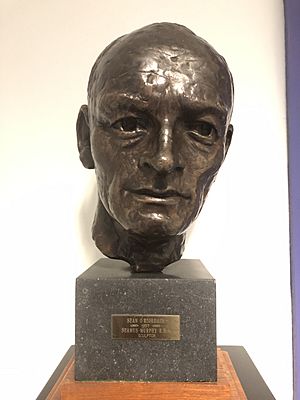Seán Ó Ríordáin facts for kids
Quick facts for kids
Seán Ó Ríordáin
|
|
|---|---|
 |
|
| Native name |
Seán Pádraig Ó Ríordáin
|
| Born | 3 December 1916 Baile Mhúirne, County Cork, Ireland |
| Died | 21 February 1977 (aged 60) Glanmire, County Cork, Ireland |
| Occupation | Poet, writer |
| Language | Irish |
| Literary movement | Modernism |
| Notable works | Eireaball Spideoige |
Seán Pádraig Ó Ríordáin (born December 3, 1916 – died February 21, 1977) was a famous Irish language poet. People sometimes called him an Ríordánach. He also wrote for newspapers. Seán Ó Ríordáin is known for bringing new ideas from Europe into Irish poetry. Many people think he was one of the best Irish language poets of the 1900s.
Contents
Discovering Seán Ó Ríordáin
His Early Life and Family
Seán Ó Ríordáin was born in Baile Mhúirne, County Cork, Ireland. He was the oldest of three children. His parents were Seán Ó Ríordáin and Máiréad Ní Loineacháin.
Even though he became a famous Irish poet, English was his first language. His mother spoke English, and his father spoke both Irish and English. His grandmother, who lived next door, was a native Irish speaker. Another neighbor also spoke Irish. These people helped Seán learn Irish quickly.
When Seán was ten years old, his father sadly passed away from tuberculosis. Five years later, in 1932, his family moved to Inniscarra, which is near Cork city. Seán and his brother Tadhg went to school at the North Monastery Christian Brothers School in Cork city.
His Career as a Writer
Seán Ó Ríordáin worked as a clerk in the Cork Motor Tax Office starting in 1936. He worked there until 1965, when he retired early because of his health.
In 1967, he became a part-time teacher at University College Cork (UCC). From 1969 to 1976, he was the "writer in residence" at UCC. This meant he was a special writer who worked and taught at the university. During this time, he also wrote a weekly column for The Irish Times newspaper until 1975.
Dealing with Health Challenges
Seán Ó Ríordáin got pneumonia when he was thirteen. After that, he was often sick for most of his life. In 1938, he was diagnosed with tuberculosis. He had to visit special hospitals called sanatoria many times throughout his life. Seán Ó Ríordáin never got married. He passed away in Sarsfield Court Hospital in 1977. He is buried in St. Gobnait's cemetery in Baile Mhúirne, with his father and grandparents.
Seán Ó Ríordáin's Poetry
Eireaball Spideoige: His First Collection
Eireaball Spideoige means A Robin's Tail. This was Seán Ó Ríordáin's first and largest collection of poems, published in 1952. The publisher, Sáirséal agus Dill, also published all his later books.
Eireaball Spideoige includes his most famous poem, Adhlacadh mo Mháthar (My Mother's Burial). The title of the book, A Robin's Tail, comes from this poem. My Mother's Burial is a very personal poem about his sadness after his mother died. When this poem was first published in 1945, it brought a new feeling to Irish language poetry.
In the introduction to Eireaball Spideoige, Ó Ríordáin explained that his poetry tried to capture "the immediacy of the moment." He also asked, "What is poetry?" and answered, "A child's mind."
When Eireaball Spideoige was first published in 1952, some people had mixed feelings about it. They thought it was different from traditional Irish poetry because of its topics and his personal way of using language. Today, however, it is seen as a very important part of Irish literature.
Other Important Works
After Eireaball Spideoige, three more collections of Ó Ríordáin's poetry were published:
- Brosna (Kindling) came out in 1964.
- Línte Liombó (Limbo Lines) was published in 1971.
- Tar éis mo Bháis (After my Death) was published in 1978, after he passed away.
His later poems were less sentimental and romantic than his first collection. In Brosna, he wrote about his sometimes difficult relationship with the Irish language. In Línte Liombó, he explored how people are shaped by destiny. All his poems were collected and released in 2011 under the title Na Dánta.
Popular Poems for Students
Seán Ó Ríordáin's poems have always been popular. This is partly because his work is often included in the standard Irish school curriculum. Poems like "Fill Arís", "Cúl an Tí", and "Tost" are very well known.
"Fill Arís" was even chosen as a finalist in a competition by RTÉ in 2015 to find "Ireland's best loved poem." "Toil" is another poem where he thinks about the limits of human will. "Cúl an Tí" is especially popular and is often taught in Gaelscoileanna (Irish-language schools) across Ireland.
His Lasting Impact
Seán Ó Ríordáin's writings had a huge influence on the Innti poetry movement, which was a new style of poetry.
A primary school in Ballincollig, County Cork, called Gaelscoil Uí Ríordáin, is named after him. This shows how important he is to Irish language and culture.



